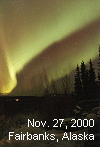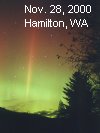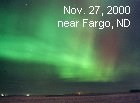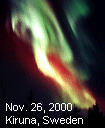|
Summary: A
remarkable sequence of solar eruptions between Nov. 24th and 27th propelled
a
series
of 5 (or more) coronal mass ejections toward Earth. One CME after
another buffeted Earth's magnetosphere from Nov. 26th to the
29th, but the repeated shocks did not trigger mid-latitude aurora
as many sky watchers had hoped. Nevertheless, observers above
55 degrees geomagnetic
latitude
enjoyed beautiful displays of Northern (and Southern) Lights.
Unless
otherwise stated, all images are copyrighted by the photographers.
Submit your images.
|
|
Photographer, Location |
Images |
Comments |
 |
Debbie
Gill-Fox, Christchurch, New Zealand |
#1 |
Debbie Gill-Fox: "This image was taken just
south of Christchurch, New Zealand, at around local midnight
(1100UTC) on 29-11-00, using f3.5, 30 second exposure, on 800
ASA Fuji film. The bright stars at the left of the image are
the Southern Cross." |
 |
John Russell,
Nome, Alaska |
#1,
#2, #3,
#4, #5,
#6 |
John Russell: "Last night (12:00 to 01:30
am local time on the 28th of Nov) I saw the most fantastic aurora
I've ever seen. I couldn't see ANY stars through the glare. Beautiful
displays lasted several hours into the morning. During these
shots I could read the LCD on my camera; it lit the landscape
up brighter than a full moon." Typical photo settings: Nikon
N90s camera; 35mm Nikkor F2.0 lens; 6 second exposures on Fuji
NHG II Pro800 film. |
 |
Jan Curtis,
Fairbanks, Alaska |
#1,
#2, more |
Jan Curtis: "On 27 Nov. at 9PM AST, based
on ACE spacecraft alert of an impending solar wind shock wave,
I waited outside at -10F as a faint curtain gave way to a active
display (#2) at 9:05PM
(L), at 9:15PM (R), #1
at 9:20PM (T), at 9:25PM (B)." Photo settings: 35 mm f/2.0
setting on Kodak Royal Gold print film. |
 |
Wade
B Clark Jr, Hamilton, Washington State |
#1, #2, #3,
#4, #5 |
Wade Clark: "This display between 12 midnight
and 12:45am PST on Nov. 28th was almost totally colorless while
viewing (except for a bit of green near the horizon). Obviously
the film picks up the colors much better than the eye. Not a
spectacular display, but beautiful nonetheless." Photo settings:
Fuji NHG II 800 speed color negative film, exposures reange from
25 to 40 seconds. |
 |
Noreen
Harding, Aberdeen, Scotland |
#1,
#2 |
Noreen Harding: "I live south of Aberdeen
in Scotland, and travelled about 4 miles inland to be free of
my village lights and the light pollution from Aberdeen. In reality
the aurora seemed faint, although we did catch a red streak at
one point, and I am amazed at the colour on these images. Exposure
was between 30 and 50 seconds at 3.5 aperture on 400 speed film." |
 |
Larry Lane,
Fargo, North Dakota |
#1 |
Larry Layne: "I took this picture at 2:45am
CST on Nov 27, 2000, just north of Fargo. It was my first photo
of the Northern Lights!" |
 |
Mark Simpson,
near Calgary, Alberta, Canada |
#1,
#2, #3,
more |
Mark Simpson captured these photos on Nov. 26,
2000 using a Pentax LX SLR camera. Film: NHGII Fuji Pro, 800ASA.
Lens: 28mm, f2.8. 4-30 second exposures. Simpson: "The third picture contains
Orion in the center; notice the very fine blue streaks in the
aurora." |
 |
Yusuke Ebihara,
Swedish Institute of Space Physics, Kiruna, Sweden |
#1 |
Yusuke Ebihara: "The picture was taken at
approx. 2000 UT on Nov. 26, 2000, when the horizontal component
of the ground magnetic field showed a negative excursion, that
is, a large substorm. Prior to this, I saw an extremely intense
red aurorae between 1830 and 1930 UT." Photo settings: Film:
Kodak Royal Gold 400; Camera: Nikon New FM-2; Lens Nikkor 24mm
f2.0. |
 |
Ryan Kramer,
Grand Forks, ND |
#1,
#2, #3,
#4, more |
Ryan Kramer: "These pics were taken from
Grand Forks, ND, on the morning of 11-26 during the early morning
(1:00 AM to 3:00 AM) I didn't expect aurora, so my camera was
mounted on a telescope at the time (hence the slightly skewed
view) and I couldn't take the time to set it up on it's own tripod." |
back
to spaceweather.com |








